A Part-Leaf from the ‘Life of Saint Blaise’
March 8, 2016 in Events, Manuscript Studies, Photographic Exhibition
Part of a Leaf from the Saint’s ‘First’ Life
in a Lectionary
Reused as Binding Material
 [First published on 8 March 2016, with updates.]
[First published on 8 March 2016, with updates.]
Here continues our blog by Mildred Budny on Manuscript Studies, for which the Contents List offers a guide to the series. Now we look at a fragment from a 12th-century manuscript containing, or partly containing, one or more saints’ lives intended for reading aloud.
A fragmentary vellum leaf in Latin now in a private collection represents a remnant of the Passio Sancti Blasii Episcopi et Martiris (‘The Suffering of Saint Blaise, Bishop and Martyr’) from a manuscript dismembered for recycled use. Laid out in double columns, the text is written in upright proto-Gothic script of circa 1170 CE from an as-yet unknown center.
Similarly, the medieval ownership of the leaf remains unknown, although the reuse as a limp vellum cover for an 18th-century paper notebook comprising a register of receipts in French presumably indicates the location of the leaf, if not the rest of its book, at least by the early modern period. Given the fragmentary nature of the surviving evidence, we’ll take all we can get.
Any and every clue might offer further information about the materials and the ‘crime’ — if the ‘crime’ in this case might involve the slaughter of the animal for its skin to serve as the original writing surface, the despoliation of the written leaf from its former manuscript home, and the removal (by whatever means) of the present unit, comprising the recycled medieval leaf as a cover and its acquired ‘filling’ as an 18th-century notebook, from its French setting as a repository for on-going records relating to a particular family’s activities. If you think that this detective work might form a species of forensics, we think that you could be right.
The Paper Register
The Register consists of 35 paper leaves. Written by different hands, the entries are often signed and dated. One of the names which features prominently in the receipts is that of Gaspard Blanc–Maulme. Not a common name, it can be found in records at Plauzat in the Department of Puy-de-Dôme in Auvergne in central France. For example, the marriages of Gaspard Blanc-Mau(l)me are recorded at Plazat respectively to Marguerite Cureyras on 2 June 1748 and to Antoinette Amblard on 2 January 1752. Perhaps one and the same man, with one short marriage followed by another. As marriage could be a form of death-sentence for women, what with the perils of childbirth across the centuries, it may not seem strange that one man had more than one wife in swift succession — whether or not that particular forcible form of short marriage might be the case here. Several individuals with the surname Blanc-Mau(l)me are recorded in Plauzat (or Plauzac) in the 18th century; some may belong to the family with the notebook.
To judge by the entries by different hands at different times, often with flourished signatures, the notebook appears to have been used by various members of the Blanc-Maulme family for sixty years or so. At least one of the entries (shown here) mentions the Seigneurie de Plauzac, using a close spelling variant for Plauzat.
It seems reasonable to assume that its owners acquired the notebook ready-made as a blank book, already bound with its reused medieval cover. The dismembered stock of leaves from the original manuscript perhaps served as a store for the stationers preparing notebooks for whatever use. However, the vertical fold-lines on some leaves, shared between leaves, as visible in the opening here, could indicate a period of travel as folded sets of leaves on their own before the binding. Further examination might settle the case.
The dates in the notebook, referring to contemporaneous transactions, clearly establish that the dismemberment of the manuscript predated by decades the upheavals of the French Revolution, when many other medieval manuscripts were converted to reuse. (Another blogpost in our series, for Budny Handlist 5 Parts A and B, will describe one such reused leaf on a post-Revolutionary notebook.)
The Manuscript and its Embellishments
Initials and section-titles or directions are rendered in bright red pigment, apparently made from a vegetal colorant which has not faded or darkened over time and through exposure, unlike the metallic red pigments found in many medieval manuscripts. The 2-line initials, inset within the text indented for them, provide M for Mox and S for abbreviated S[an]c[t]e on the front and back covers respectively, with an extended tail for the M descending into the margin for 6 more lines.
These simple elements of embellishment in a single color contrasting with the brown ink of the main text place this part of the original manuscript, at least, at a lower, and cheaper, scale of book-production than the more elaborate constructions with decorated or figured initials, and more, as are well known among medieval books of distinction. Some of them are illustrated in our blogposts. Who knows what elements the rest of this text, and the manuscript as a whole, may have contained?
The Limp Vellum Cover
On the fragment there survive the top 22 lines of the double columns of both sides of the leaf, plus part or most of the former upper margin and the margins to either side. Removed from its former book, the leaf was trimmed down for its reuse and folded with turn-ins, so as to fit the size of the 18th-century paper notebook. Endpapers, originally blank, were pasted onto the inside front and back covers, covering the turn-ins of the vellum leaf. The owner’s photographs of the inside front covers, shown below, employ back-lighting so as to reveal more of the features of the layered structure, including most of the text on the surviving portion of the verso and parts of the 2 lowermost surviving lines of text on the recto, which occupy the bottom turn-ins. Those turned-in lines bring the total on the surviving part-leaf to 22 lines per column, for which 20 lines are visible on the front and back covers of the notebook.
Within the cover, the notebook contains a handwritten register of receipts in French, plus some sums placed in several orientations on the front endpaper, as the volume was opened at times from one end or the other and held upright or upside-down relative to the main texts in adding these entries. A partly revised ink inscription at the top of the front endpaper declares the dates de 1729 au 1730[?] (‘from 1729 to 1730’). Other dated entries within the notebook refer, for example (see the illustration above of one opening in the book), to 1722, 1726, 1726 (corrected to 1727 in different ink) and 1732 (thrice).
The surviving portion of the medieval vellum leaf retains the full extent of its original inner and broader outer margins flanking the columns of text (columns ‘a’ and ‘b’). With its text turned upright as the limp vellum cover, the expanse of the leaf wraps around the volume to place its right-hand portion (column b) at the front and its left-hand portion (column b) at the back. Double brown cords (probably hemp) stitch the spine of the cover to the notebook, with long more-or-less vertical stitches running along the former intercolumn. A pair of vellum ties laced through the front and back of the cover, aligned more-or-less midway down its outer edges, forms a single tied closure.
Damage of various kinds has affected the leaf to considerable extents, through such agents as rubbing, wear, tear, and wormholes. Parts of the cover have folded backward or torn into shreds. The wormholes, pronounced on the part of the leaf which now serves as the front cover, must have been acquired in proximity to the wooden board of a former cover at an extended period in the history of the manuscript.
Now we survey the visible parts of the manuscript, its turn-ins, and its pasted endpapers.
The Front Cover
The Back Cover
The Inside Front Cover and its Endpaper
The Inside Back Cover and its Endpaper
The Text on the Turn-In Viewed Upright
Now we consider the implications, and the deductions.
Lection IX
The rubricated title •Lectio •IX• (‘Lection IX’) fits into the end of line rb17, marking the beginning of the next section for reading in church or in refectory. Some other posts in our blog on Manuscript Studies describe such practices, as attested by the manuscripts. A notable case is the monumental Lectern Bible (‘Otto Ege Manuscript 14’), now cut into dispersed remnants, and bearing many marks for lection by its community or communities.
The Former Recto, Virtually Reconstructed
A photographic montage permits a view of the double columns side by side.
The Former Verso, Virtually Reconstructed
The Passio Sancti Blasii
The surviving portions of the text correspond to the version — one of several — of the Passio Sancti Blasii in the edition by the Italian humanist Bonino Mombrizio (1424–1482). This version appears in his Sanctuarium seu Vitae Sanctorum (‘The Sanctuary [or Shrine], or the Lives of the Saints’), as reprinted by the Benedictines of Solesmes Abbey (Paris, 1910), volume I, pages 150–153. The published Acta Sanctorum also reprints Mombrizio’s version, however with collations ex vestustissimis MSS. (from ‘the oldest manuscripts’) as the Prima Acta (‘First Register’) out of four Acta for this saint in the first volume for the February saints (printed in 1735). That edition of the Acta divides the text into chapters and sections, whereas the edition of 1910 prints it as a series of long lines, ‘pure and simple’.
On the manuscript leaf, the text picks up mid-sentence with the words uobis tormenta . . . in line ra1, that is, on the back cover. They correspond to line 17 on page 152 in Mombrizio’s Benedictine edition (the Sanctuarium), that is, the one which presents long lines undivided into sections. The text in the 18 lines of this manuscript column that is visible on the outside of the cover spans printed lines 17–21, leading to the word descendentes / [de caelo et salutantes eas dicebant eis: Nolite dubitare: . . . ], by which the following lines of text might be reconstructed, and perhaps a leaf surviving somewhere might be identified. After a gap in the text imposed by the trimming and folding of the leaf for its reuse, column rb1–18 spans printed lines 29–35, extending from beatissimo mulieros to et flecentes genua dixerant at the damaged bottom of the cover. Abbreviations included, this coverage amounts to some 4 to 6 lines respectively of 1910 printed text per column of script thus visible from the original recto.
The next 2 lines of both columns, folded backward and inward toward the inside covers (that is, toward the original verso), continue the text to a slightly further extent, at present difficult to discern fully — although the printed edition in long lines provides an approximate guide. The text missing from the bottom of both columns on the recto as visible on the cover amounts to some 5 lines of the printed edition, while their 18 lines fully visible there correspond to some 6 printed lines.
Let us say that, roughly, the surviving 20 lines per column may equal nearly 7 printed lines. That estimate entails gaps of some 5 printed lines, or, perhaps, some 15 more manuscript lines, to reach a total of about 35 lines of script per column on the leaf. A big book.
(An aside. For those who say, as someone earnestly did recently, that a beginning for identifying a detached leaf’s former manuscript, or center of production, should proceed with a count of the number of lines on the page, plus evidence of preparation, say of pricking marks, and then move to comparison with whatever manuscripts might survive, wherever, I say that, in this case, I do not see that the surviving evidence allows for so precise a calculation of line-numbering. Good fortune for others who might do better! Please let us know; we would be glad to learn. But I digress, albeit with a point. Back to now.)
The text on the verso, as revealed more readily with back-lighting, through the paper pastedown and apart from the vellum turn-ins, extends in column b to demersi sunt in profundo / [aque . . . ] in its line 18, corresponding to line 3 on page 153 of the edition. Allowing for a bit more text underneath the turn-in, its remaining span would, say, amount to another few lines of the printed text.
The former span of this leaf, when complete, may have amounted to somewhat less than one-third of the full span of the Passio, which covers nearly 171 long lines in print. That is, provided this copy presented the complete text, anyway according to the 1910 edition.
The surviving portion of the text corresponds to part of Chapter III of the edition in the Acta Sanctorum, there entitled VII. Sanctarum mulierum martyrium. The portion extends, with gaps, from within section 10 (its line 8) to section 12 (somewhat farther than its line 4). This Acta runs in full from printed page 336 column b to page 339 column a; this portion of it appears on page 338, running from column a to column b.
Comparison with this edition reveals that a variant reading in the manuscript corresponds with some other early witnesses. In Section 11, beginning Mox autem, the phrase quod pro sanguine lac carnes earum stillabant of the edition, ‘our’ witness has the verb guttabant (but spelled as gutabant) for stillabant, as attested, according to the textual apparatus of the edition, in Mss. Gladb. & S. Max. (referring to manuscripts in, or from, Gladbach Abbey and perhaps Saint Maximinus Abbey in Trier, although I have not yet identified them). From such details may emerge a view, albeit partial, of the place of the fragment in the transmission of the text.
Apart from the rubricated lection number, which implies lections previous to its number IX, and the nature of the subject-matter, there seems little way of knowing what other texts the former manuscript contained. A collection of saints’ lives, found in a widespread genre in medieval books, would have provided models for reflection and, it may be, emulation, through reading aloud to the community.
Saints’ Lives, Passions, and Legends
If it was a Latin Lectionary composed, in all or part, of the deeds of saints, the former manuscript could have resembled some extant examples from the early medieval period, including some in large format. The massive ‘Cotton–Corpus Legendary’, preserved in several states of transmission from the 11th century onward, presents a compilation of hagiographical texts for liturgical feasts celebrated throughout the ecclesiastical year.
That Legendary or Passional arranges its accounts of the lives, deaths, and miracles of various martyrs and confessors according to the saints’ feast days in their order around the year, plus some prefatory texts. Those texts provide tables for calculating various dates and an ecclesiastical Kalendar of saints’ days throughout the year. The earliest extant version of the Cotton–Corpus Legendary, now divided between London and Cambridge, emerged at Worcester Cathedral Priory in the 11th century, with later additions, including inscribed drawings illustrating the text; now its texts address some 170 saints. A description of the genre, and the manuscript, appears in Mildred Budny (1997), number 41; part of this Legendary has an online facsimile.
Its texts show that its compilation, in multiple volumes, was modeled upon a Continental collection, with certain adjustments for English and Worcester use. In particular, it closely reflects a Northern French exemplar, as many of its texts concern Northern French saints. This case could provide a model for one range to which the former manuscript with ‘our’ text of Saint Blaise aspired. The simpler booklet devoted to Saint Blaise in particular now in Philadelphia offers another. The actual case, of course, could have fitted somewhere in between.
Unless or until other parts of the original manuscript can be identified, or the work of the scribe can be recognized among other manuscripts, it seems difficult to assess what approach and what bias (such as regional or local affiliations in terms of saints’ patronage) this former case would or could have attained. The wormholes, however, help to indicate that this manuscript had a binding with wooden boards, and so its ‘Life of Saint Blaise’ did not circulate, at least during that long period, on its own as an unbound item. They also demonstrate that this copy of the ‘Life’ stood fairly close to one of the boards, and so it came close enough to the front or back of the book. Such traces can, at least, reveal some parts of the unspoken and unwritten history — so far as we know — of the leaf and its former manuscript setting.
The Saint and His Deeds
About Saint Blaise, perhaps an early 4th-century Bishop of Sebasteia in Anatolia or Armenia (now Sivas in Turkey), the accounts differ and derive from multiple sources, some legendary. They include Greek and Latin sources, as well as some in other languages.
Apparently circa 316 this Blaise was martyred, perhaps by Agricolaus, Governor of Cappadocia and Lower Armenia, during persecutions under the Emperor Licinius I (ruled 308–324). The monumental Acta Sanctorum (‘Deeds of the Saints’), gathering together the Latin sources for various saints, records that Blaise, Bishop and Martyr, was martyred by being beaten, attacked with iron combs, and beheaded. Renowned as a healer and restorer, he is credited, while still alive, with curing a boy choking on a fish bone and with commanding a wolf to return a pig, unharmed, which it had stolen from a poor woman. Her gift to him of 2 fine candles to light his darkened cell or cave provides one of the attributes by which the saint’s representations might be identified as his. Another attribute is the iron comb which symbolizes his mode of martyrdom. A popular saint, Blaise of Sebasteia (or Sebaste) became, among other things, the patron saint of animals, wool-combers, and the wool trade.
In the Latin West, his feast day is customarily celebrated on 3 February, but on 2 November in the East. Various churches are dedicated to him in different countries. His relics are claimed to survive in several locations.
Among them arises the compelling single Arm Reliquary preserved at the Herzog Anton Ulrich-Museum in Brunswick, Germany, and shown here in photographs by Ludwig Schneider (released and reproduced via Wikipedia Commons). Encased in metal and bedecked with jewelry, including an impressive array of rings, this reliquary formed part of the imposing group of gifts by Gertrud die Ältere von Braunschweig (died 1077) to Dankwarderode Castle and to its Church dedicated to Saint Blaise.
A 13th-century copy of a different account of the Passio of Saint Blaise than ‘our’ version combines its text with readings and chants for a Mass for the saint, plus the additions of several other short texts and drawings. Now MS LJS 418 at the University of Pennsylvania, this unit of 8 leaves may have circulated on its own, as a form of manual for his cult. A digital facsimile of the entire booklet is freely available here and (as ebook) here.
The text of its Passio begins with a brief rubricated title, set above the top line, and a decorated initial within a block-like frame. At the bottom of the opening page stands the added drawing in ink of an upright bishop, wearing a mitre and the pallium of his office, and holding a crosier in his outstretched right hand and a closed, bejeweled book clasped to his chest in his left hand. The sketch may represent a rendition of this worthy episcopal saint.
Viewing the Saint
Closer, perhaps, to home, a detailed cycle of scenes from the life and death of Saint Blaise survives among 12th-century frescos on the walls of the Romanesque ‘Chapel of the Monks’ at Berzé-la-Ville in the Department of Saône-et-Loire, France. A detailed study of the cycle appears, for example, by Elizabeth Lapina (2005), with illustrations. A watercolor copy by Louis-Joseph Yperman (1856–1935) printed in 1893 demonstrates its scenes of Saint Blaise, including his beheading. Some photographs of the cycle itself are freely available, as with this same scene, or the full cycle and the close up for this saint.
Manuscripts, too, depict multiple episodes concerned with Blaise’s deeds. A vivid set of painted scenes within a quartered full-page frame in a 14th-century Legendarium now in the Biblioteca Apostolica Vaticana (MS Vat. Lat. 8541, folio 52v) presents the saint variously sitting among wild beasts, pausing to heal the boy as soldiers approach, causing the wolf’s return of the pig, and standing resolute during the comb-carding process. The manuscript, commissioned by Charles Robert of Anjou, or Charles I, King of Hungary (from 1308 to 1342), was produced circa 1330 and illustrated by artists expertly in Bolognese style. The detailed illustrations, drawn from the Golden Legend, known variously as the Legenda Sanctorum (‘Readings of the Saints’) or Legenda Aurea (‘Golden Readings’), an immensely popular compendium of saints’ lives, provided material for meditation and contemplation of worthy, admirable, and fanciful stories. Gore included. No wonder, perhaps, so popular.
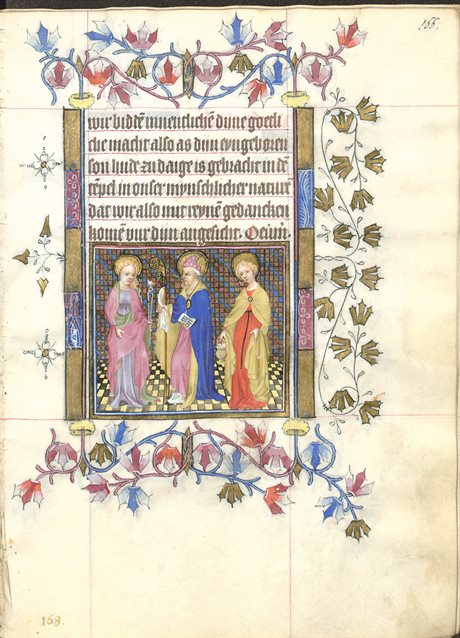 Benign views of the saint are plentiful, too. A dignified example occurs in the ornate Prayerbook of Maria van Gelre, copied in 1415 by Helmich die Lewe for Mary, Duchess of Guelders (1378–1427). Its saints for February depict Blaise as bishop standing between 2 female saints in a tiled interior. Their rich garments and calm demeanor bear little trace of the agonies of martyrdom, apart from an amputated breast clamped in tongs for an attribute, as these saints pose in a timeless world — timeless, that is, despite their fashionable and timely raiment fit for the devotions of a woman of high stature.
Benign views of the saint are plentiful, too. A dignified example occurs in the ornate Prayerbook of Maria van Gelre, copied in 1415 by Helmich die Lewe for Mary, Duchess of Guelders (1378–1427). Its saints for February depict Blaise as bishop standing between 2 female saints in a tiled interior. Their rich garments and calm demeanor bear little trace of the agonies of martyrdom, apart from an amputated breast clamped in tongs for an attribute, as these saints pose in a timeless world — timeless, that is, despite their fashionable and timely raiment fit for the devotions of a woman of high stature.
 With or without images, original or added, the former manuscript with ‘our’ leaf from the Passion of Saint Blaise participated in some way in the transmission of knowledge, and lore, about this elusive saint, for whom stories abounded, more and less fanciful and manifestly captivating. After all, who could and can resist a good story? Especially when a variety of them circulated for this saint, and, it seems, by turns, competed for attention or joined forces in a compilation of episodes which might be welcomed by the expanding traditions of his cult in both the Western and Eastern Churches. We lament the despoilation of the original manuscript, but we ought to thank the preservation, by one means and another, of its fragment in a new setting, which has come to our notice and, through our chance to study and present it more widely, to yours.
With or without images, original or added, the former manuscript with ‘our’ leaf from the Passion of Saint Blaise participated in some way in the transmission of knowledge, and lore, about this elusive saint, for whom stories abounded, more and less fanciful and manifestly captivating. After all, who could and can resist a good story? Especially when a variety of them circulated for this saint, and, it seems, by turns, competed for attention or joined forces in a compilation of episodes which might be welcomed by the expanding traditions of his cult in both the Western and Eastern Churches. We lament the despoilation of the original manuscript, but we ought to thank the preservation, by one means and another, of its fragment in a new setting, which has come to our notice and, through our chance to study and present it more widely, to yours.
We hope that you like this opportunity. Please let us know!
*****
Afterwords: Some Useful References for Further Reading and Browsing
about the Saint, his History, his Iconography, and his Cults
We thank the owner of the composite Register for permission to study and to reproduce its materials.
A few references, including those mentioned in this post, may set the stage for further exploration.
- Boninus Mombritius / Bonino Mombrizio, ed., Sanctuarium, seu vite sanctorum [probably printed in 1480]; novam hanc editionem curaverunt duo monachi Solesmenses [i.e. D.A. Brunei et D.H. Quentin] (Paris, 2 volumes, 1910), volume I, pages 150–153.
- Johannes Bollandus and Godfredius Henschenius, eds., Acta Sanctorum (Antwerp, 68 volumes, 1643–), Tomus Primus Februarii (1735), pages 331–353: ‘De sanctis martyribus Sebastenis Blasio Episcopo’, with the ‘Prima Acta ex vestustissimus MSS. & Bon. Mombr.’ on pages 336–339, including textual apparatus reporting variants from some of those manuscripts. A transcribed version of this Acta appears here.
- Jules Baudot and Léon Chaussin, eds., Vies des saints et des bienheureux selon l’ordre du calendrier avec l’historique des fêtes (Paris, 13 volumes, 1935–1959), II (1936): Février, pages 62–67: ‘Saint Blaise, Évêque et Martyr’.
- Istituto Giovanni XXIII della Pontificia Università Lateranense, Bibliotheca Sanctorum (12 volumes, 1961–1970, plus Index and Supplement, 2013), III: Berna–Ciro, columns 157–170: ‘Biagio, vescovo di Sebaste in Armenia, santo, martire’.
- Wolfgang Braunfels, ed., Lexikon der christlichen Ikonograhie (Rome etc., 1973), V: Ikonographie der Heiligen Aaron bis Crescentianus von Rom (1973), columns 416–419: ‘Blasius (Vlasij) von Sebaste’.
- Mildred Budny, Insular, Anglo-Saxon, and Early Anglo-Norman Manuscript Art at Corpus Christi College, Cambridge: An Illustrated Catalogue (2 volumes, 1997), number 41: ‘The Corpus Portion of the “London–Cambridge Legendary”: The Earliest Extant Witness to the ‘Cotton–Corpus Legendary” ‘.
- Elizabeth Lapina, ‘The Mural Paintings of Berzé-la-Ville in the Context of the First Crusade and the Reconquista’, Journal of Medieval History, 31:4 (2005), 309‒326.
Happy Hunting! Also, if you know of, or come across, another part of this manuscript, or some manuscripts which look much like this one in terms of script and layout, please let us know. We hope to learn about the survival of more remnants from its time, place, and center.
*****
Next stop in our blog: More manuscript fragments, reproduced, identified, and set into context.
*****

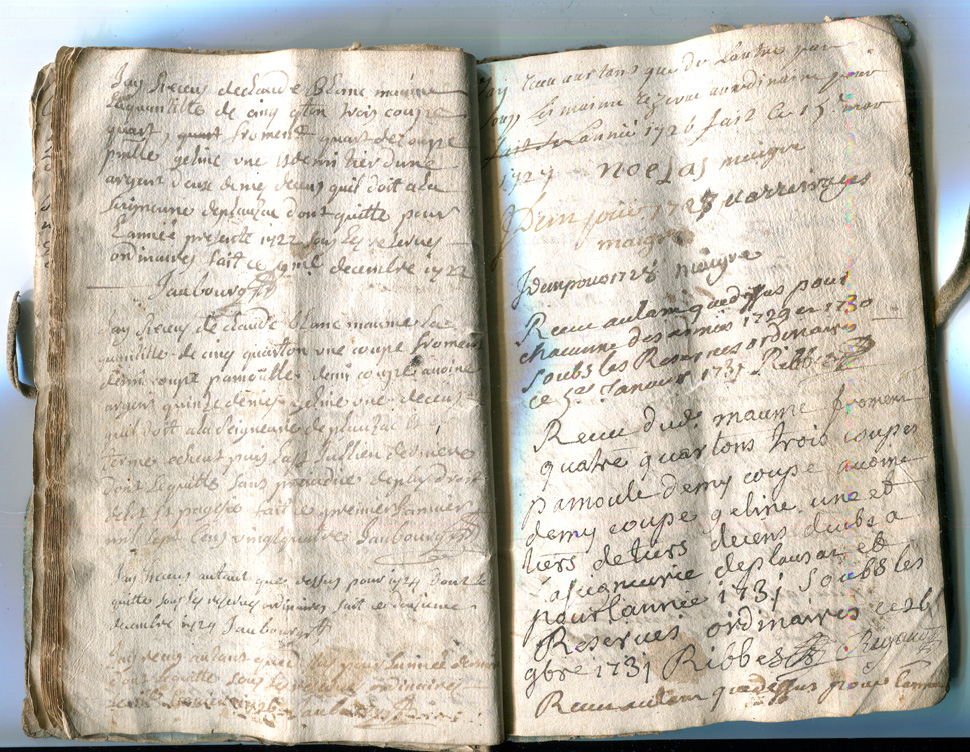


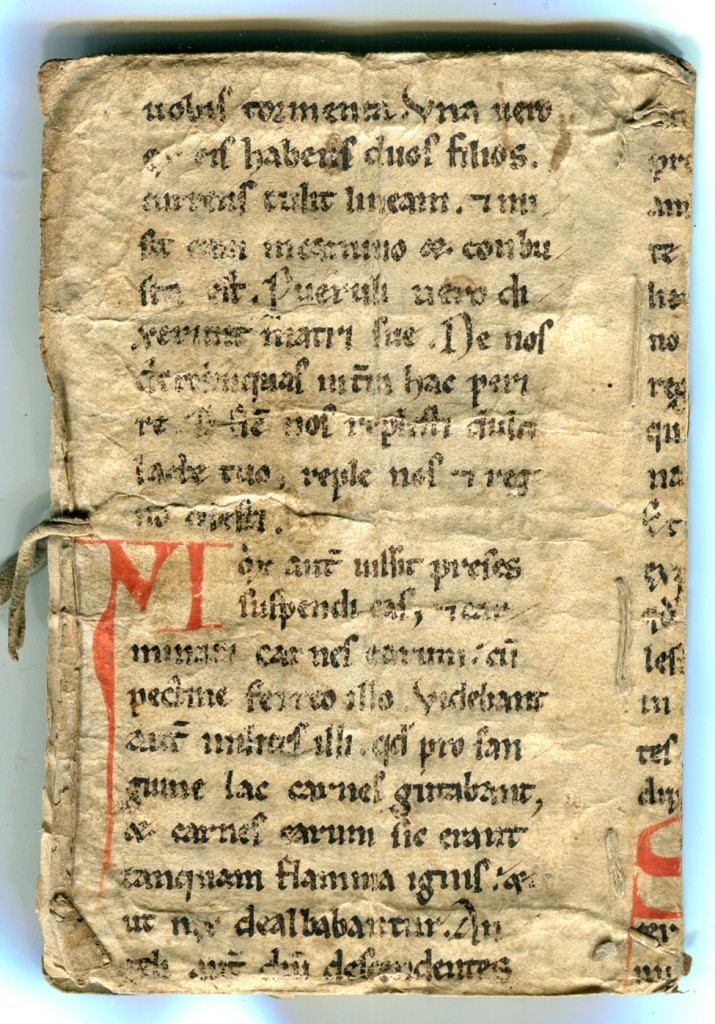
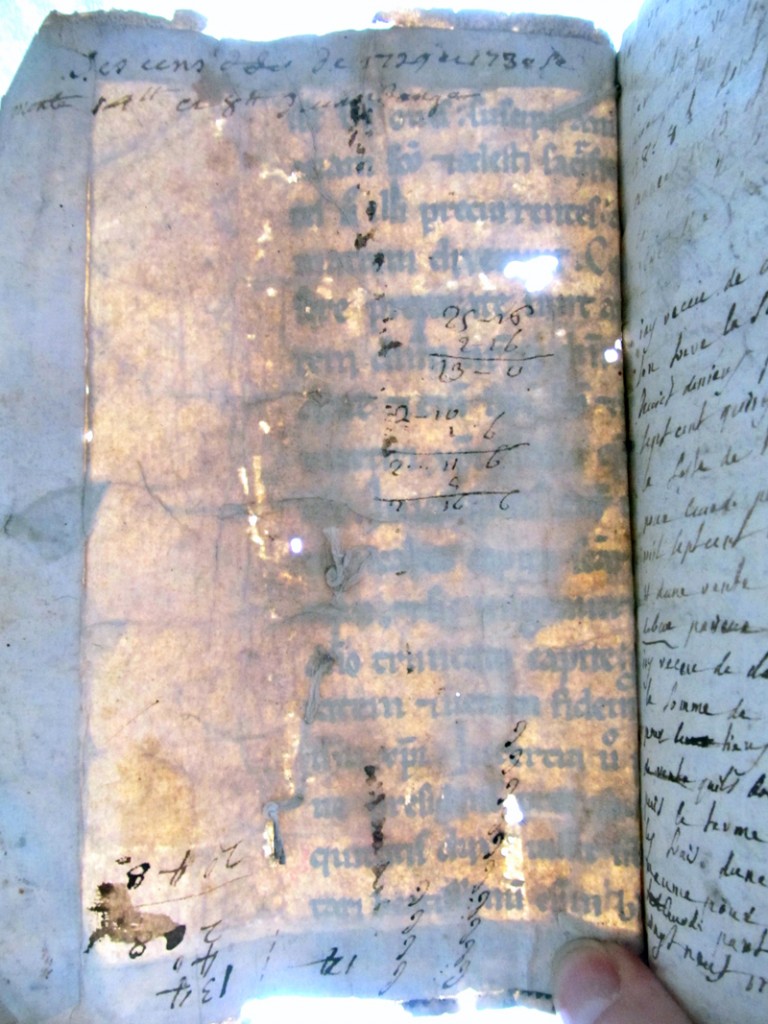
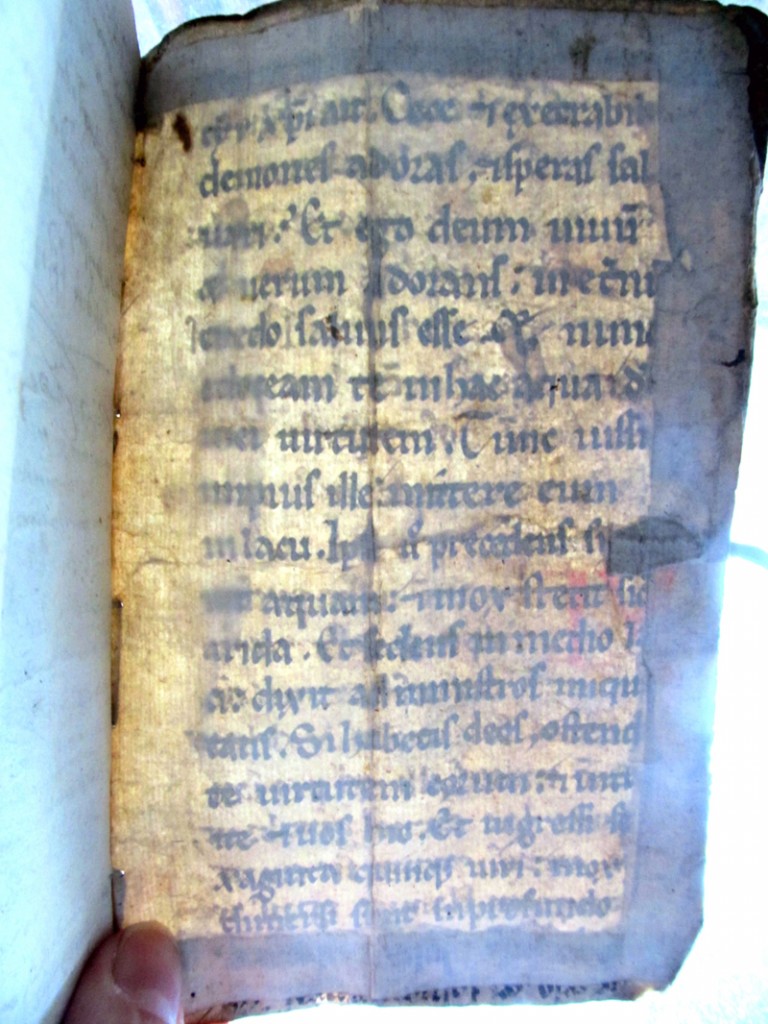
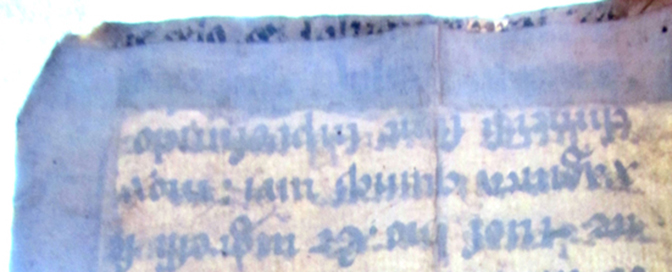
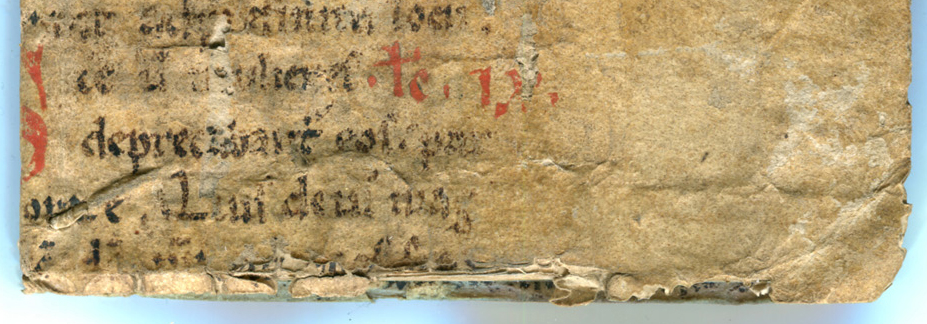

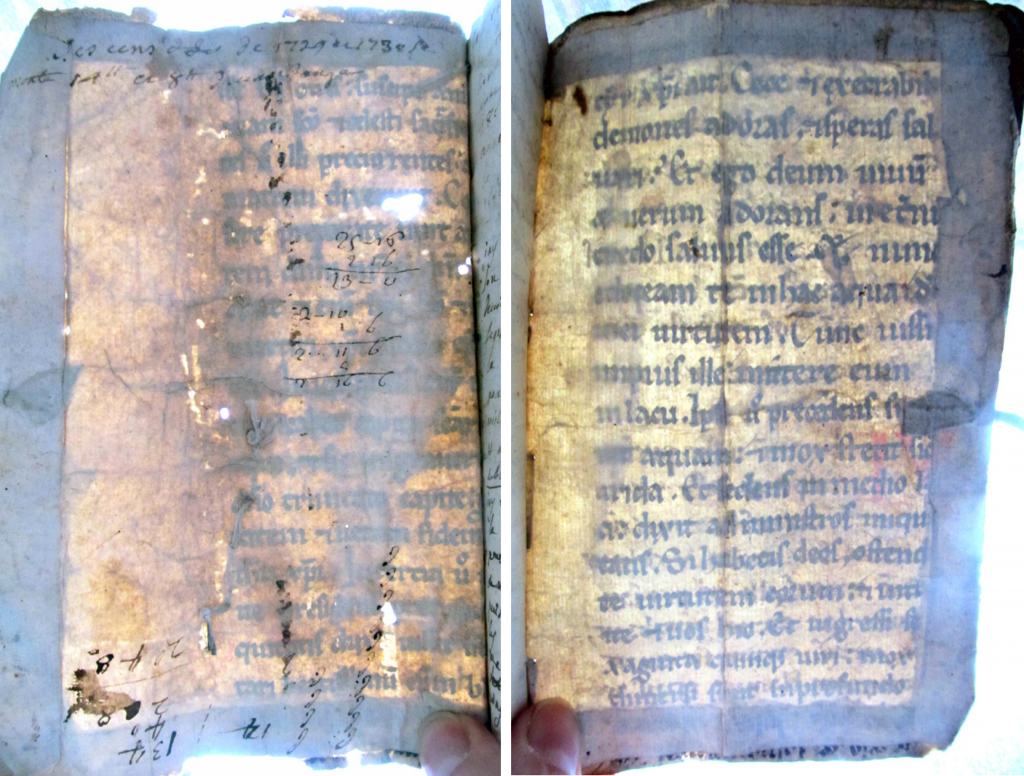
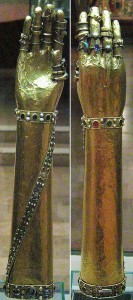
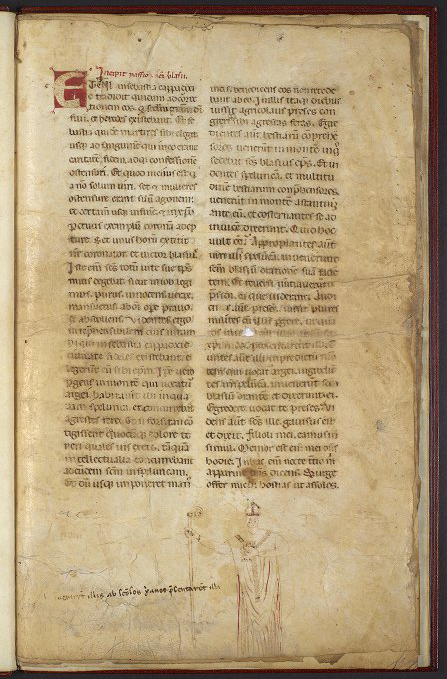
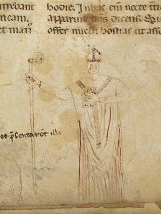
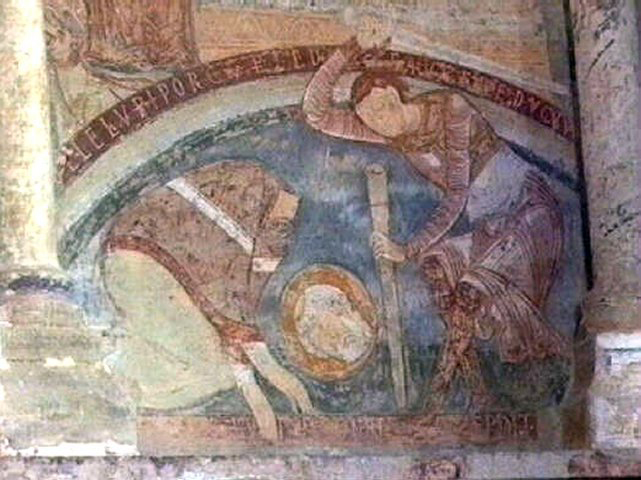
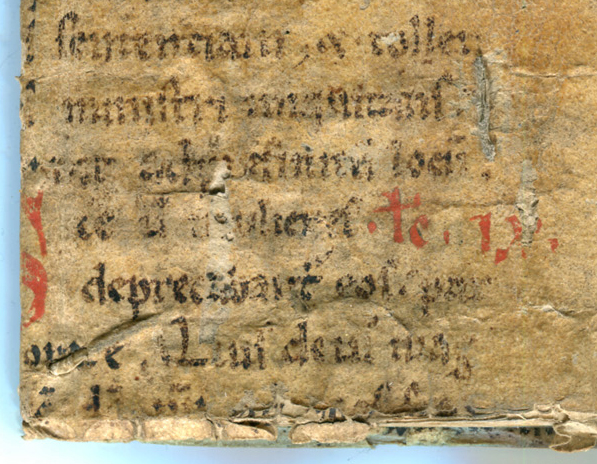
This article is truly a pleasant one it helps new net people, who are wishing for blogging.|
So glad to hear! Thank you for your interest. We look forward to hearing more from you.
Hi Author,
These are incredible tips!You’re the best !Extremely accommodating.Thanks for useful writing
Hi Author,
Thanks for sharing your wow tips. Make sure all are happy to follow these tips.